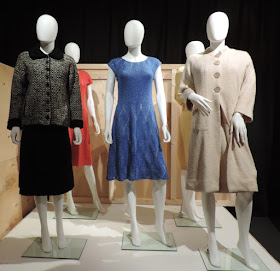On Friday, I took a train to Barnsley to see the
Knitwear: Chanel to Westwood exhibition at the Civic. I had already seen the exhibition at the Fashion and Textile Museum in Bermondsey, but it is worth a second visit (especially as there is free entry at the Civic).
The exhibition is based on the collection of Cleo and Mark Butterfield, who have been collecting vintage fashion for many years. It's a mixture of machine and hand-knits, and from couture to high street. As the title suggests, there are pieces attributed to Chanel, from the 1910s and 1920s, as well as pieces by current designers including Vivienne Westwood.
 |
| 1920s knitwear, some attributed to Chanel |
Also from the 1920s were some rayon jumpers and dresses, mostly crocheted. We have many similar jumpers in the Knitting & Crochet Guild collection, whereas we don't have any wool jumpers of that age that I can recall - maybe all the woolly jumpers were either eaten by moths, or reknitted into something else during the Second World War. I particularly liked a filet crochet jumper in pale orange rayon, with a large flower motif worked across the front. An enlarged illustration from the original pattern is displayed on the wall behind it, and I recognised the illustration, from
Fancy Needlework Illustrated.
 |
| Fancy Needlework Illustrated No. 67 |
There was a very colourful display of 'Fair Isle' knits (though I don't know whether any of them were actually from the Shetlands). I spent some time admiring them, and trying to date them individually - there were some from the 1940s, and some from the 1970s or later.
I have been researching some of the Fair Isle knits and patterns in the Guild collection recently, so I was very gratified that I could identify the patterns behind some of the knits. One pattern was particularly easy to recognise, because the colours of the pullover match those in the pattern.
The Stitchcraft Men's Book was published in the late 1940s - presumably the pullover also dates from then. Two other pullovers in the display were I think knitted in the 1970s, both to the same pattern, I believe.
They are I think both knitted from Patons pattern 1595, though it's fascinating to see the difference that the choice of colours makes - including a much darker colour in the mix completely changes the overall look. It seems to have been a very popular pattern - as well as these two pullovers, there are at least three items in the Guild collection that were knitted from it, that I showed
here.
 |
| Patons 1595 |
And there were other Fair Isle knits in the display which I didn't recognise at all - that was just as interesting.
A few of the garments on display were made by Cleo Butterfield for herself. One in particular struck a chord with me - a cardigan knitted to a Patricia Roberts design.
The label says
"The mammoth task of completing this complex cardigan, using a huge range of different stitches to create a picture of three-dimensional bees, flowers and a beaming sun partially obscured by clouds, was so great that, once it was finished, Cleo didn't have the energy to attach buttons." At least she finished the knitting - I had an unfinished Patricia Roberts knit that I kept for years, until I finally
ditched it last year.
Some of the commercial machine knits were very appealing too - I liked these two pieces by Ossie Clark (left) and Biba (right) from the early 1970s.
There is no catalogue of the exhibition, but many of the garments on display are featured in
Vintage Fashion Knitwear by Marnie Fogg - one of my birthday presents
four years ago. When I first saw the
Chanel to Westwood exhibition in Bermondsey, I was puzzled that some of the garments seemed familiar, until I realised that I had seen them in the book.
In the same gallery at the Civic is a small display of garments from the Yorkshire Fashion Archive. They are a small selection of the clothes designed and hand-knitted by Isora Steinart for her daughter Nita Hyman. The selected pieces are from the late 1950s and early 1960s - all beautifully made and very elegant.
The exhibition is on until November 14th - and there is a lot more in it that I haven't written about. If you haven't seen it and are within reach of Barnsley, I can recommend it.






















